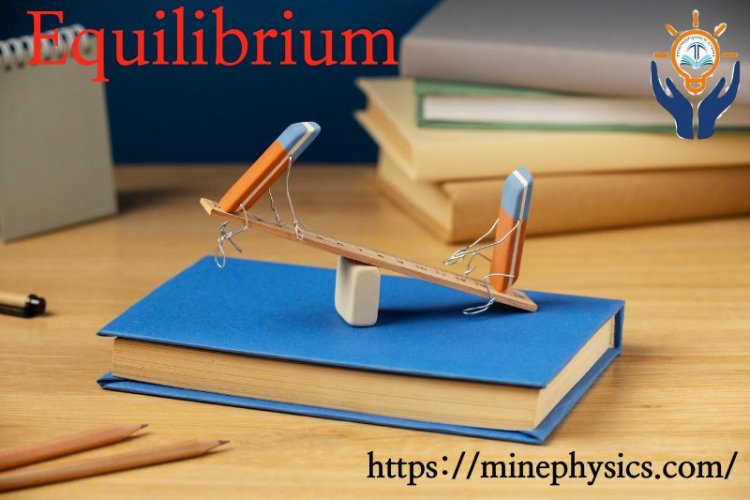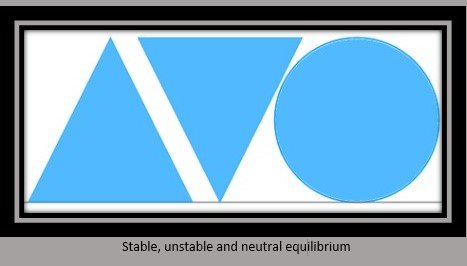Equilibrium and its Types
Equilibrium is the state where opposing influences cancel out, with three types: static, dynamic, and stable. Static equilibrium remains constant, dynamic equilibrium fluctuates, and unstable equilibrium drifts away.

Definition:
It can be defined as the state of a body in which two or more opposing influences, internal, external, or a combination of them, act on the body and cancel each other out to keep the thing in the same state it was in. The word "equilibrium" comes from the Latin word libra, which means "weight" or "balance".
Here are some examples:
A book kept at rest on a table
The car moves at a constant speed
A chemical reaction where both backward and forward reactions proceed at the same time
Types:
1)Static Equilibrium:
It is also known as mechanical equilibrium, which refers to the state in which an item or system is at rest or moving at a constant speed. In this case, the net force acting on an object or system is zero, and the net torque (rotational force) is also zero. This means that no acceleration or rotation occurs.
To achieve it, the forces and moments acting on an object or system must balance. This can be achieved by several factors such as the location of the forces, the distribution of masses, and the location of the center of mass.
Conditions:
Net Force: The vector sum of all external forces acting on a thing or system must be zero. This ensures that there is no overall force causing linear acceleration.
Net Torque: The vector sum of all external torques acting on an object or system must be zero. This ensures that there is no general torque causing rotational acceleration.
Translational Balance: Forces acting in all directions must be balanced. This means that the sum of the forces in the x, y, and z directions (if any) must individually be zero.
Rotational Balance: Moments acting at any point must balance. This means that the sum of the torques must be zero for any pivot point or axis of rotation chosen.
Dynamic Equilibrium:
It refers to a state where opposing processes or forces occur at the same rate, resulting in an overall system that is stable despite constant change. Unlike static equilibrium, it involves constant movement and change, but the system remains in equilibrium over time. It can be observed in a variety of contexts, including physical, chemical, and biological systems.
Here are some examples:
Physical Systems: A classic example of dynamic in a physical system is the swing of the pendulum. As the pendulum swings back and forth, it reaches a point where the gravity pushing it down is counterbalanced by the tension in the string, resulting in a constant, repetitive motion.
Chemical Systems: In a reversible chemical reaction, this equilibrium occurs when the forward and backward reactions proceed at the same rate. This means that while the reactants are continuously converted to products, the products are simultaneously converted back to reactants. The concentrations of the reactants and products remain constant over time even as the reactions continue.
Biological Systems: It is often observed in biological processes. For example, homeostasis in the human body involves maintaining a dynamic balance of various physiological variables such as body temperature, pH levels, and blood sugar levels. The body constantly adjusts and adjusts these variables to keep them within a narrow range.
More Types:
Stable, Unstable, and Neutral are three separate types of equilibrium that can be further divided based on an object's position and stability. Take a look at the image below:

The first triangle-shaped object will come back to its original state if an outside force is applied, tilting it slightly. The term "stable equilibrium" refers to this kind. On the other hand, if the same procedure is carried out again with a second triangle-shaped body, the body will continue to deviate away from its first position until it achieves a new point. A state like this is referred to as an unstable equilibrium. If the third sphere-like item is moved around the surface by a specific amount, it will still come to rest in an equilibrium state there object holds a stable position at every location on the surface. The term "neutral equilibrium" refers to this kind.
Here are some examples:
Stable Equilibrium:
In this type, the system tends to return to its original position or state when disturbed. It can be thought of as a ball sitting at the bottom of a concave shell. If it moves slightly off the bottom, it returns to a stable position. Examples of stable equilibrium are:
a)A book placed on a flat table: if the book is moved slightly from its place, it will return to the table on its own.
b)Ball in the Valley: When the ball moves in the valley, it rolls under the influence of gravity.
c)Pendulum at rest: After the pendulum has stopped, any slight disturbance will cause it to swing back and forth, eventually returning to its vertical equilibrium position.
Unstable Equilibrium:
It is a condition where a system is in equilibrium, but any small disturbance will cause it to drift away from its original position. It can be likened to a ball swinging precariously on top of a hill.
Examples: 1)Pencil balanced on tip: When the pencil is on the tip, the slightest movement will cause it to fall in any direction.
2)Ball on top of a hill: If it is on top of a hill, any minor foul will cause the ball to roll off the top.
3)Ball on an inverted bowl: If it is placed in an inverted bowl, it will be unstable and tip over on a slight shift.
Neutral Equilibrium:
It occurs when a system remains in equilibrium regardless of its location. In this case, any movement does not lead to a tendency to return to the starting position or to move further away.
Examples: a)A box sliding at a constant speed on a frictionless surface: the box continues to move at a constant speed without being accelerated in any direction.
b)Sphere Floats in Water: If the sphere floats in water and neither sinks nor rises, it remains in a state of neutral.
c)Shelf with evenly spaced books: As long as the distribution of books on the shelf remains balanced, the shelf will be in neutral condition.
What's Your Reaction?





















